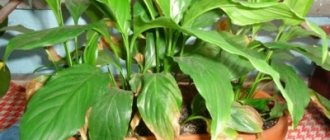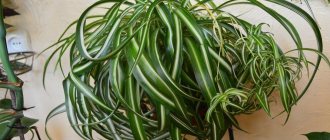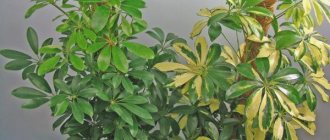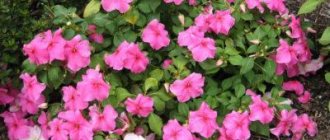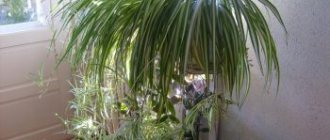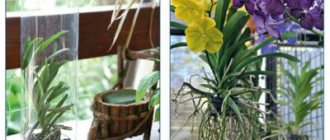The herbaceous perennial chlorophytum is very popular among lovers of indoor plants: it is not too demanding to care for, is compact and elegant, and is often used in flower arrangements and as an hanging plant. However, in order for the bush to always look attractive and neat, caring owners must closely monitor its appearance and promptly notice features that may indicate that the plant is suffering and is in danger.
Leaves become limp and pale
The plant requires bright, diffused light. The variegated varieties of chrophytum are especially demanding for this, while the green-leaved varieties easily tolerate slight partial shade. In low light conditions, chlorophytum quickly withers, and the color of its foliage becomes less saturated and faded.
Plants also suffer in conditions of overheating and insufficient soil moisture. In a room environment, especially in the spring-summer period, chlorophytum must be watered quite often and abundantly, and also pamper the plant with nutritional supplements at least once every 10 days, alternately using organic compounds and mineral fertilizers for these purposes, otherwise the plant will quickly wilt and become sickly, weakened appearance.
To keep the plant in good shape and look fresh, do not allow dry, stagnant air in the room, regularly ventilate the room, but at the same time protect the flower from drafts and extremely cold temperatures for it - below 10 ° C.
Causes of black leaves of chlorophytum
Darkening of the leaf plate indicates improper care. Although chlorophytum is unpretentious, it requires comfortable conditions for full development. The main factors that affect leaf health are:
Air humidity. In summer the problem rarely occurs. Air comes in from open windows. Outdoor air humidity is much higher than room humidity. Dry ends occur more often in winter. Heating devices dry out the already dry air in the room;
Hard water. With prolonged watering with tap water, the tips of the leaves begin to darken. Chlorine, which is added to disinfect water, accumulates in the soil and adversely affects the health of the leaves;
Dust. Pollution disrupts the life processes of green mass;
Direct sunlight. The rays hitting the leaves through the window glass are very hot. They can deform a leaf plate in just a day;
Incorrect feeding. If you choose the wrong fertilizer, the leaves will darken. The same reaction will occur if the dose and timing of application are incorrectly calculated;
Insecticides in concentrated doses. The chemical will destroy pests along with the foliage. The reaction from the plant appears a few days after treatment;
Insufficient watering. The soil in the pot should not dry out or become compacted;
Natural aging process. Over time, the foliage turns yellow, regardless of the quality of the flower. The dying parts just need to be cut off.
Blackened tips and leaves with mechanical damage are cut off with sharp scissors or pruners. It is necessary to form a point so that the plant has a neat appearance.
Pests and diseases. Some pests suck juices from plant tissues and first leave yellowish spots, which may darken over time (spider mites, thrips, whitefly larvae). On honeydew left by pests (scale insects, mealybugs, aphids), sooty fungus often appears and the leaf blade becomes covered with a black coating.
And another fungal disease - powdery mildew - first appears on the leaves in the form of a grayish coating, and then black spore-bearing spots appear. The fungal disease anthracnose in some species manifests itself in the form of brown spots that gradually turn black. Fusarium causes the appearance of weeping brownish spots on the leaves, and then dark spore-bearing spots. Late blight (late blight) first appears as purple-brownish spots, which then turn black. When a flower is affected by gray rot, first a fluffy grayish coating appears on the leaves, under which the spots eventually become brown or black.
Leaves become covered with brown spots
The leaves of chlorophytum begin to become covered with brown spots if the plant suffers due to regular excessive watering, and, as a result, prolonged stagnation of moisture in the soil. This usually happens in winter, when watering, according to the rules, should be reduced, but due to the high dryness of the air in the room, heated by radiators and radiators, the owners, fearing a lack of fluid in the plant, tend to water it more often and more intensively than necessary.
Due to an excess of moisture in the root space, the tuberous root system of chlorophytum begins to rot. If you do not fundamentally change the approach to caring for the plant, it may die in a very short time. To avoid this, you should make it a rule to additionally water the plant only when the earthen ball has dried out by ¼ of the total volume of the flower pot.
Pests
When wondering why chlorophytum does not shoot arrows, does not grow, and black spots form on the leaves, you need to check whether the plant is infected with pests. Diseases and pests of chlorophytum are rare, but it is necessary to know about them in order to take action in time, since the affected plant can quickly turn yellow and dry out.
Why do monstera leaves turn yellow - diseases and pests
The most dangerous for the flower:
- thrips;
- spider mite;
- scale insect
Insects can be detected if you carefully examine the ground part. It is the external signs that help determine which pest attacked the flower. After this, you can decide on control measures.
Important! You need to look for ways to deal with pests as early as possible, before they actively breed. If there are a lot of them, insects can completely destroy chlorophytum.
The type of pest can be determined by the following characteristics:
- A gray coating in the form of cotton wool appeared - a mealybug.
- Dryness and yellow spots indicate that thrips have appeared.
- Leaves become curled and distorted due to aphid infestation.
- If a flower is attacked by a scale insect, you can see pale leaves with dark spots.
Infestation of a flower with scale insects is easy to detect
To destroy scale insects yourself at home, you must first wipe the leaves with a sponge soaked in a solution of water and laundry soap. After this, you can treat with any anti-parasite agent.
One of the most dangerous pests is the spider mite. It appears due to too dry air. The mite feeds on cell sap, which causes the leaves to wither. To get rid of the pest, it is necessary to spray 4-5 times a day with an insecticidal solution.
Chlorophytum requires enhanced care at home. If the leaves turn yellow, you can find out what to do by determining the cause. Compliance with the maintenance rules will help you grow a beautiful flower that will delight you with its blooming.
Multi-baker Redmond RMB-611
2172 ₽ More details
Multi-baker Redmond RMB-611
2172 ₽ More details
Large meat grinders
The rosette of leaves begins to rot
The rosette of leaves of a chlorophytum bush may begin to rot due to waterlogging of the soil or due to the fact that the substrate is too heavy and does not suit the composition of the plant. The ideal soil mixture ratio for chlophytum consists of sand, turf, humus and leaf organic matter in a ratio of 1:2:2:2.
How to create ideal living conditions
Despite the sufficient unpretentiousness and vitality of chlorophytum, providing an optimal environment for the home has a beneficial effect on the appearance and immunity of the plant. The culture is thermophilic and develops well with sufficient lighting without direct sunlight. An indoor flower needs systematic watering and moistening of the green mass.
Sudden changes in day and night temperatures and drafts should not be allowed. Regular ventilation of the room is recommended. If chlorophytum does not grow, there may be a lack of nutritional components, the flower pot is too small or large for the rhizome. It is important to consider the time of year and growing season. Thanks to proper care, you can not only achieve preservation of the color of the leaf blades, but also flowering, which is rare for indoor conditions.
When cultivated in an unfavorable environment, the leaves lose the color characteristic of the variety, become stained, rot or dry out at the ends. In most cases, damaged leaf blades will not recover, but eliminating the influence of unfavorable factors and proper care will lead to the chlorophytum growing new green mass.
Chlorophytum readily absorbs tobacco smoke and various toxic compounds (formaldehyde, carbon monoxide) emitted by furniture, floor coverings and plastic panels. At the same time, the appearance of the flower does not suffer at all, because chlorophytum feeds on these harmful emissions and these are undoubtedly plants.
This plant is especially valued for its unique property of purifying and disinfecting the air.
. With proper care, chlorophytum rarely gets sick from any of them. If your pet suddenly begins to turn yellow and lose the brightness of its color, it is worth establishing the cause of the disease and trying to help it.
Signs and superstitions associated with chlorophytum
Belief in the magical properties of chlorophytum speaks of the noted properties of the plant to help people in different areas of life.
Well-known superstitions about the benefits of the chlorophytum flower say:
- It is recommended to enter a new home with chlorophytum to create a positive atmosphere and fill the place with comfort. It will be easier to take root in a new environment with this indoor plant.
- It is believed that the plant withers and loses its beneficial properties in a house where there is constant quarreling and swearing, a negative atmosphere and negative energy reign. It serves as an indicator and tells you when relationships with household members become strained and the time has come to try to improve them.
- Chlorophytum is called the “bridal veil” because the flowers resemble wedding decorations. Single people buy it to find love and family happiness. The plant will help strengthen existing relationships, make them stronger and more trusting.
- A good omen is considered to be the flower sprouting shoots. If there are more than 20 - 30, it means that the person will be successful: his financial condition will improve, and bright, joyful moments will appear in his life.
What does orange chlorophytum look like, what family does it belong to?
The herbaceous perennial is distinguished by a variegated emerald hue, the wide leaves are pointed and glossy. Closer to the base they narrow significantly, reaching 25-30 cm in length, 5-10 cm in width, the edges are slightly wavy. Growing from the center of the basal rosette on elongated petioles, the leaves hang in a lush cascade in different directions. The total height of the plant reaches 45-60 cm in natural conditions and 25-30 cm in containers at home. The root system has a tuberous shape and is quite strong. The stem is shortened, the side shoots bloom over time. The smell of chlorophytum is pleasant and soothing. The flowers on the plant are arranged spirally.
Chlorophytum orange
Additional Information! Chlorophytum orange has other names: winged, star orchid and orchidastrum. This is due to the specific structure of the leaves and the shade of the petioles (pale pink or orange).
The bush is classified as a member of the Asparagus family, the birthplace of the flower is South Africa. The plant is perennial and lives on average 10 years.
Main varieties
There are several types of this plant. Each of them has characteristic features.
Crested
Chlorophytum crested is a variety that is more common than others. This variety is recognized by the presence of a branched rosette, from the center of which green leaves with a pronounced lightened center or light, almost creamy edges emerge.
Cape
The difference between this variety is its wide but long leaves. They stretch up to 60 centimeters. Cape chlorophytum is grown in hanging pots.
Orange
The central vein of the leaves and petioles have a pronounced orange tint. This plant is characterized by stem elongation up to 30-40 centimeters.
Laxum
Compact variety with a small leaf rosette. The leaf blades along the edges acquire a pale, almost white, tint.
Borivilianum
A variety that is recognized by the wavy edge of each leaf. The leaves are an attractive emerald green color.
Brief description of the flower
Chlorophytum curly is a fairly common specimen, often found in apartments and offices. The tropics and Africa are considered the homeland of the perennial, where it grows directly on the bark of trees. Exotic belongs to herbaceous plants, and scientists are still arguing about its relationship to a certain family: first the Liliaceae family was mentioned, then the Asparagus family.
A distinctive feature of chlorophytum is its hanging narrow leaves, on which there are peculiar tendrils that form young bushes with aerial roots. The plant's soft white flowers, resembling stars, form panicles.
Sheet plates have several color options:
- green;
- creamy green;
- white-green.
Under suitable conditions, the plant is a voluminous cascade of leaves up to 80 cm long. Chlorophytum is distinguished by a fleshy root system that accumulates a large amount of moisture. If the exotic plant is not watered for some time, it will grow and develop beautifully due to this moisture.
The perennial takes root very easily, its life expectancy is more than 10 years.
Prevention measures
Preventative measures are very important. They help reduce the risk of various chlorophytum diseases. Lovers of indoor plants who are planning to add this plant to their collection or have it in their collection are advised to pay special attention to preventive measures.
- For a plant to grow well, it needs good soil. You should choose the right soil for this particular flower. When purchasing soil, it is better to give preference to a substrate that has neutral acidity. You should choose a substrate that allows water and air to pass through perfectly.
- To reduce the risk of various parasites appearing in the substrate, it is recommended to treat it before using it for planting or replanting. Thus, the soil can be calcined or treated in a water bath (depending on the type of soil substrate).
- An important preventive measure is compliance with all microclimate indicators. It is better to place the plant in a well-lit place, and also monitor the optimal temperature and humidity in the room. If for some reason the air in the room where the flower “lives” decreases, then it is recommended to think about the possibility of purchasing special home air humidifiers - humidifiers. Having such a device in a home where air humidity is reduced is a necessity, not a luxury.
- To keep the leaves and roots of the plant in good condition, you should not forget about regular watering. It is better to water the flower with water that has been previously settled.
- We should not forget about transplantation. Experts recommend carrying out this procedure only when necessary. Some (especially beginners) home plant lovers abuse replanting. This often leads to the fact that in the future the flowers begin to grow poorly due to damage to the root system. In order not to damage the plant, it should be replanted correctly - in compliance with special technology.
- Another important preventative measure is to conduct regular plant inspections. To do this, you need to inspect the leaves. During such a “home inspection” you should pay attention to the color and elasticity of the foliage. And also upon inspection you can notice pests and parasites on the leaves. If they have been detected, then there is no need to delay treatment. Delayed treatment can lead to the death of the flower.
